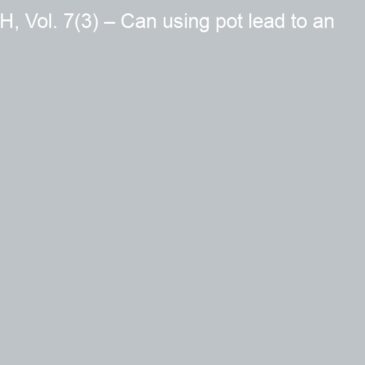Use of cannabis – the most popular illicit drug in the world – is associated with psychotic disorders (Wittchen et al., 2007). However, it is not clear if using cannabis actually prompts psychosis or vice versa. This week’s STASH reviews a study that examines if cannabis use among adolescents increases the risk for having psychotic experiences 10 years later (Kuepper et al., 2011).
Method
- Adolescents from Germany, aged 14-24 at baseline, participated in the study. The baseline sample was randomly drawn from the population registry office of Munich metro area. Kuepper et al. analyzed data from 1923 participants who had no missing information for three periods of time.
- Researchers collected demographic and psychiatric information at baseline. Researchers assessed cannabis use at the baseline, 3.5 years later (T2), and 8.4 years later (T3) with a dichotomous question: “Have you ever used cannabis five times or more?”
- A clinical psychologist collected data about psychotic experiences at time T2 and T3 during face-to-face interviews using a version of an international diagnostic interview M-CIDI (Wittchen, Lachner, Wunderlich, & Pfister, 1998). If the participant declared occurrence of any of 20 classic psychotic symptoms (e.g., hallucinations, persecution), the presence of psychosis was recorded.
Results
- At baseline, 247 participants (13%) reported cannabis use.
- Table 1 demonstrates that the cannabis exposure at baseline was associated with psychotic experiences at T2 and T3. In addition, the incidence of cannabis use between baseline and T2 significantly increased the incidence of psychotic experience between T2 and T3 (odd ratio =1.9; 95% confidence interval = 1.1 to 3.1; p < .03). This relationship is independent of age, sex, socioeconomic status, use of other drugs, childhood trauma, and urban/rural environment, and only among people who had no cannabis use at baseline and no lifetime prevalence of any psychotic symptoms at T2.
- There was a significant correlation between the continuation of cannabis use and risk of persisting psychotic experiences (?2= 16.22, p < .01).
- On the other hand, people who reported experiencing psychotic symptoms at T2 were not more likely to begin using cannabis between T2 and T3 (odds ratio = 0.8; confidence interval = 0.6 to 1.2; p = 0.3). Psychotic experience at T2 or T3 was not associated with cannabis use at earlier stages.
|
Cannabis use* |
Psychotic symptoms at T2 | Psychotic symptoms at T3 | ||
| Yes | No | Yes | No | |
| Baseline | ||||
| Yes | 81 (4%)
|
166 (9%)
|
42 (2%)
|
205 (11%)
|
| No | 355 (18%) | 1321 (69%) | 189 (10%) | 1487 (77%) |
| T2 | ||||
| Yes
|
126 (7%)
|
267 (14%)
|
69(4%)
|
324 (17%)
|
| No | 310 (16%) | 1220 (64%) | 162 (8%) | 1368 (71%) |
Figure. Psychotic experiences at times T2 and T3 for individuals exposed and not exposed to the cannabis at baseline and T2. N = 1923.
Limitations
- This is a correlational study that cannot determine causality, but only the temporal relationship between use of cannabis and psychosis experiences.
- The results are based on self-reported cannabis use and psychotic experiences
- The researchers did not collect information about the family history of psychosis.
Conclusion
The results of this study clarify the temporal relationships between use of cannabis and psychosis experience. These results imply that cannabis use can predict the incidence and persistence of psychotic experiences later, but not vice versa. Psychotic experiences are not uncommon in general population and – when abnormally persistent – they can progress to clinical state. It is unclear, however, if the psychotic experiences associated with cannabis use (rather than, for example, family history) are also associated with psychotic disorders. The mechanism underlying the effect of prolonged cannabis on persistence of psychotic experiences is not clear yet.
-Julia Braverman
What do you think? Please use the comment link below to provide feedback on this article.
References
Kuepper, R., van Os, J., Lieb, R., Wittchen, H. U., Hofler, M., & Henquet, C. (2011). Continued cannabis use and risk of incidence and persistence of psychotic symptoms: 10 year follow-up cohort study. BMJ, 342, 738.
Wittchen, H. U., Lachner, G., Wunderlich, U., & Pfister, H. (1998). Test-retest reliability of the computerized DSM-IV version of the Munich-Composite International Diagnostic Interview (M-CIDI). Social Psychiatry Epidemiology, 33(11), 568-578.





Peter Reynolds March 17, 2011
It’s worth looking closely at this study because very quickly the incredibly weak nature of its conclusions become clear.
It’s not about clinically diagnosed psychosis at all. It’s about what may be just one trivial thought or mental confusion in the space of 10 years. The authors call it “subclinical expression of psychosis in the general population…that is, expression of psychosis below the level required for a clinical diagnosis.” Astonishingly, that’s enough for a “positive”.
Once you delve behind the headlines, phrases like “might under certain circumstances” start to appear and then you realise how meaningless the study’s conclusions are.
Something else that nearly all the reports of this study have missed out is the authors statement that “The evidence on cannabis and psychosis has influenced the decision in the UK to retain criminal penalties for cannabis use, despite evidence that removing such penalties has little or no detectable effect on rates of use. An informed cannabis policy should be based not only on the harms caused by cannabis use, but also on the harms caused by social policies that attempt to discourage its use, such as criminal penalties for possession and use.”
Putting Cannabis “Research” Into Perspective.